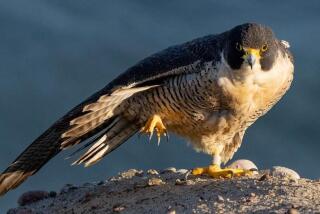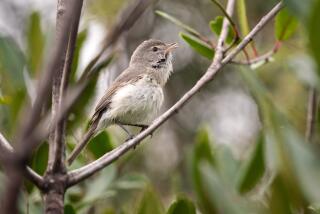Annual ‘Hawk Watch’ Sees Birds of Prey Rebounding
- Share via
KEMPTON, Pa. — Every autumn, the raptors flee the cold Canadian wilderness and soar southward, kept aloft by columns of heat that rise from the earth and updrafts bouncing off the Appalachian Mountains.
The migratory route carries the birds--bald eagles, Cooper’s hawks and an occasional rare golden eagle--over Hawk Mountain Sanctuary, about two hours north of Philadelphia, where wildlife researchers in 1998 reported another record number of sightings.
Conservationists believe these birds of prey are thriving because the air, water and land are cleaner than 50 years ago, when pollution and pesticides were destroying raptor populations.
“Many of these species are no longer environmental basket cases, as they were earlier this century,” said Keith Bildstein, the sanctuary’s director of research and education. “You have different kinds of raptors doing well, which to me suggests it’s a widespread phenomenon and a healthier environment.”
During the annual four-month “hawk watch” that ended in mid-December, researchers counted 24,196 raptors, including at least 16 species. That count was the ninth highest in the sanctuary’s 64-year history. The largest number counted was 40,698 in 1978; the annual average is 17,827.
This year’s total included 144 golden eagles, 154 bald eagles and 1,121 Cooper’s hawks--at least three times the annual average for each species. The last record for golden eagle sightings was 100, set in 1995; for bald eagles it was 136, also set that year; and for Cooper’s hawks it was 786, set in 1989.
Bildstein said the lowest count for golden eagles was 12 in 1966; for bald eagles it was 13 in 1974, and for Cooper’s hawks it was 61 in 1964.
Raptors migrate from as far north as Greenland to as far south as Argentina. Bildstein said the birds rely on “thermals,” or columns of rising hot air, for at least part of their migratory journey.
“Thermals will allow them to soar south using far less energy,” he said. “To a large extent, many of our migrants are solar-powered birds.”
Corky Potter, director of Shavers Creek Environmental Center, an extension of Penn State University in Centre County, agreed that a cleaner environment has contributed to the increased sightings, but he cited other reasons, including the reintroduction by man of once-endangered species and weather pattern changes that draw birds from other migratory routes.
National Audubon Society researchers also believe an emphasis on conserving habitats and preserving land has contributed to higher counts, said Cindy Dunn, executive director of the society’s state office.
“I think there’s an increase in the number of people feeding birds and providing backyard habitats,” she said.
The disappearance of the pesticide DDT, which had a disastrous effect on the bald eagles’ reproductive process before it was banned nearly three decades ago, is believed to be one reason for the increased populations of that species.
The 2,400-acre Hawk Mountain was founded by conservationist Rosalie Edge to stop the indiscriminate killing of migrating hawks and eagles along the eastern edge of the Appalachian range.
Thousands of birds were killed in the late 1920s and early 1930s. The Pennsylvania Game Commission once offered a $5 bounty for northern goshawks. And until 1969, it was legal to kill a Cooper’s hawk. The birds are now protected by federal law.
The sanctuary attracts about 90,000 visitors a year. They hike its miles of trails and climb its high ridges to enjoy the panoramas and observe the raptors.
“Hawk watching has grown from being unheard of at the beginning of this century,” Bildstein said. “Today it’s a sport, but it’s also making significant contributions to our knowledge of raptors.”
More to Read
Sign up for Essential California
The most important California stories and recommendations in your inbox every morning.
You may occasionally receive promotional content from the Los Angeles Times.













